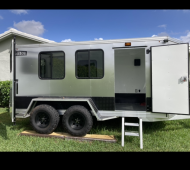I have a 16' cargo trailer. I would like to run a 6000 BTU window AC on eco mode. Presumably this is gonna be around 500 watts. I was going to buy an Ecoflow Delta Pro + spare battery (7.2kwh) for a total of about $5000. Plus the solar panels. Not cheap.. to say the least.
I do not need anything more than a few lights, chargers, and a fridge powered, besides the option to have air conditioning. Maybe an occasional hair trimmer or such. I plan on driving cross country and want to make sure I have the option for AC if I get caught in hot weather and can't find shore power. I have a medical condition that makes too much heat intolerable.
Should I be investing all this money just for the option of having AC? Or am I crazy. I genuinely could get by with a sub $1500 setup if it weren't for the AC debacle. Any tips would be appreciated. Should I be looking at other cooling methods instead of a really big battery/solar system? I would want the option to have AC running throughout the night, so like 12 hours. Thanks.
I do not need anything more than a few lights, chargers, and a fridge powered, besides the option to have air conditioning. Maybe an occasional hair trimmer or such. I plan on driving cross country and want to make sure I have the option for AC if I get caught in hot weather and can't find shore power. I have a medical condition that makes too much heat intolerable.
Should I be investing all this money just for the option of having AC? Or am I crazy. I genuinely could get by with a sub $1500 setup if it weren't for the AC debacle. Any tips would be appreciated. Should I be looking at other cooling methods instead of a really big battery/solar system? I would want the option to have AC running throughout the night, so like 12 hours. Thanks.



